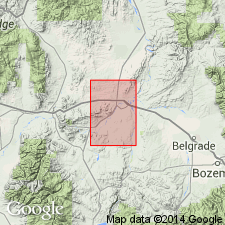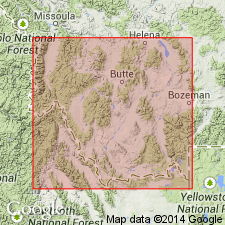
- Usage in publication:
-
- Milligan Creek formation*
- Modifications:
-
- Named
- Dominant lithology:
-
- Limestone
- Mudstone
- AAPG geologic province:
-
- Montana folded belt
Summary:
Named as a formation in the Bozeman group (raised in rank) for exposures in low hills north of Hwy 10 S and west of Milligan Creek, Jefferson Co, MT in the Montana folded belt province. Section measured in E1/2 sec 11, NW1/4 sec 12 and SW1/4 sec 1, T1N, R1W designated the type area. Composed of yellowish-gray to yellowish-brown, white to orange, thin- to thick-bedded, fine-grained, calcareous mudstone to clayey limestone at type where 295 ft were measured. Base covered by Quaternary alluvium. Gradational contact with the underlying Sphinx conglomerate, basal formation of the Bozeman group at the edge of the basin. Considered older than the Climbing Arrow formation (new) of the Bozeman. Exposed over an area of 3 sq mi and thought to underlie another 2 sq mi. Its original extent was probably less than 100 sq mi. Assumed to be Eocene age because of fossils found in the younger Climbing Arrow formation. Thought to be of eolian-lacustrine origin. Geologic map.
Source: GNU records (USGS DDS-6; Denver GNULEX).

- Usage in publication:
-
- Milligan Creek Formation*
- Modifications:
-
- Not used
Summary:
Historical use of formal stratigraphic nomenclature applied to Bozeman Group in southwest MT, Montana folded belt province described. Charts. Bozeman and its formations --Sphinx Conglomerate (oldest), Milligan Creek, Climbing Arrow, Dunbar Creek, Sixmile Creek of the Toston-Clarkson Valley areas, and the Renova (oldest) and Sixmile Creek Formations of the Jefferson-Beaverhead Valley areas not used. These Tertiary rocks considered to be basin-fill deposits separable on basis of sequence stratigraphic concepts, rather than on lithostratigraphic principles. Lithologic distinctions within the group are not distinctive due to abrupt lateral facies changes. These rocks are separable into 5 sequences, numbered 1 to 5, no. 1 is the oldest; no. 5 is post-Bozeman alluvium. Each sequence is separated by an unconformity. Term unconformity applied in this paper to surfaces of non-deposition or erosion; these surfaces have soils developed on them. Sequence 1 consists of calc-alkalic flows, flow tuffs, tuff, matrix-supported conglomerate, some massive sandstone about 157 m thick, and is of Eocene age. Sequence 2 is mostly fluvial channel conglomerate, sandstone, mudstone, siltstone, and minor tuff, lapilli tuff about 400 m thick, and is of Eocene and Oligocene age. Sequence 3 is fluvial sheet sandstone, some mudstone, siltstone, sandstone, lenses of conglomerate of flood plain origin about 214 m thick, and is of Oligocene and Miocene age. Sequence 4 is mudstone, siltstone, sandstone, lenses of conglomerate mostly of flood plain origin 1,000 m thick, and is of Miocene and Pliocene age. Sequence 5 unconformably overlies rocks that were assigned to the Bozeman. Map shows distribution of the 5 sequences. The unconformities can be traced into the subsurface seismically.
Source: GNU records (USGS DDS-6; Denver GNULEX).
For more information, please contact Nancy Stamm, Geologic Names Committee Secretary.
Asterisk (*) indicates published by U.S. Geological Survey authors.
"No current usage" (†) implies that a name has been abandoned or has fallen into disuse. Former usage and, if known, replacement name given in parentheses ( ).
Slash (/) indicates name conflicts with nomenclatural guidelines (CSN, 1933; ACSN, 1961, 1970; NACSN, 1983, 2005, 2021). May be explained within brackets ([ ]).

